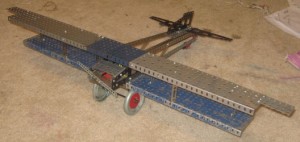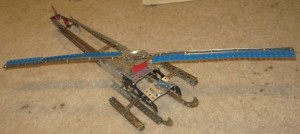![]() It’s Time to bolt! This article originally appeared in my earlier blog site.
It’s Time to bolt! This article originally appeared in my earlier blog site.
These three models were designed to be simple enough for my daughter to assist. At this time, she was only six, so Erector was still a little beyond her age bracket.
This simple hammerhead-style crane features a swiveling top, and a crank-driven lift. The model was very light weight, so it couldn’t lift very much. But that didn’t stop my daughter from having great fun with it.
This airplane model is something I came up with after looking at some illustrations of heavy planes and bombers from the World War I era. They tended to have wings that were proportionally too large for their fuselage, and they were often quite slow. The engines of the time couldn’t deliver the thrust of later ones, so a larger lifting surface was provided to make the most of whatever power the engine could provide. Improvements in engine technology eventually made this issue moot, resulting in heavier planes that were more compact in design, faster, and more stable.
This model was equipped with a turning propeller, that was attached to a strong rubber band going through the body of the plane. It didn’t use a crank, but the propeller could be “wound up,” then allowed to spin freely until the band ran out of torque. The result was akin to those gliding balsa wood planes with wind-up propellers. Of course, this model couldn’t really fly.
This helicopter was a big hit with my daughter. It’s supposed to represent one of those heavy, cargo-carrying helicopters that are sometimes seen around seaports. Or, the military variants that deliver soldiers and supplies to an inaccessible area. It’s not clear in this picture, but a crank on the opposite side of the model drove a pair of miter gears within the body of the helicopter, and a sprocket. The miter gears drove the main rotor, while the sprocket and chain turned the steering rotors in the tail.
Incidentally, this was the first time I made real use of a sprocket and chain in a model. Sprockets and chains appeared sparingly throughout Erector’s history, as an alternative to pulleys and bands. There was some evidence that chains were more efficient at transferring power than pulley bands, but even so, they were never promoted much. I suspect the reasons were cost (chains were more expensive to make than pulleys), and maintenance (changing the length of a chain is a real chore, and without the right tools, breaks are a given). At any rate, I made very good use of chains in a future model.
The chains and sprockets I used were reproductions of the Class-III era parts from the early 1970’s, and were acquired from Joel Perlin.




